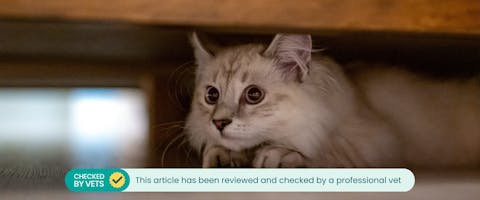Updated 11/12/2023
Wondering how to tell the age of a kitten? Usually you don’t need to find out for yourself, as the rescue centre or mother cat’s owner will have told you their age. However, if you’ve found or inherited a young kitten, it can be really tricky to work out even their approximate age.
Why is it important to know a kitten’s age? Because cats grow up so fast, a four-week-old baby has really different needs to an eight-week-old kit. If you suddenly find yourself with a small bundle of fluff to look after, you need to be aware of what they need, especially if you can’t get them to the vet immediately.
Even if you know your new kitten’s age (right down to their birthday!), it’s still fascinating to know their stages of development. We’ll take you through the best ways to tell how old kittens are, followed by a typical development timeline.
Trending posts
Purr-use some of the top blogs our members have been loving this month- Top male dog names for your new furry friendGot a new furry family member in your pack? Check…

- Top female dog names for your new fluffy palWelcoming a new pooch into your family? Explore…

- 250+ gray cat names your silver feline will loveRecently welcomed a fluffy gray bundle of joy into…

- What are normal pet sitting rates?Discover the average pet sitting rates for animals…

- Unique dog names to stand out from the packDare to be different with our list of the best…

How can you tell how old a kitten is by weight?
How to tell the age of a kitten isn't always easy for new pet parents, but often, a kitten’s weight and size might seem like the obvious starting place. It’s not always the most reliable way to tell a kitten’s age, as weight can vary depending on breed, health and what sort of start the kitten had in life: a stray is not going to be as plump as a pedigree with a well-fed mother.
However, we can still get a vague ballpark by comparing our kitten to the average weights. Here’s how to tell how old a kitten is by weight (roughly):
- A newborn weighs around 3.5 oz
- A healthy kit then gains about a quarter ounce every day. So, by the end of week one, we’re looking at an increase to 5.25 oz
- Week 1-2: 4-6 oz (113-170g)
- Week 2-3: 6-8 oz (170-225g)
- Week 4-5: between half a pound and a pound (225-450g)
- Week 6-7: between a pound and 1.5 pounds (450-680g)
- Week 7-8: between 1.5 and 2 pounds (680-900g)
What about older kittens? It has been suggested that kittens weigh the same amount in pounds as their age is in months. This is a rough estimation and there is no scientific research to back this up. A two-month kitten would weigh two pounds as we’ve just seen, and then this increases at a steady pound-a-month rate until they reach their adult size (the average cat weighs around 10 pounds).
How to tell the age of a kitten by teeth
This is a really good way how to tell how old a kitten is. If they’re a really teeny-tiny kit, spotting teeth will tell you if they’re under or over two weeks old. So, if they have no teeth, they’re under a fortnight old, and if they have teeth, you can refine your knowledge further by which teeth they have. Caution: these teeth may be tiny, but so are pins and needles…
How to tell how old a kitten is by teeth? You need to know what happens, and when. Here’s a guide to when a typical kitten’s teeth appear:
- Incisors. Their baby teeth start to poke through at two to four weeks, and the incisors are usually the first to appear.
- Canines. These start to show through the gums when a cat’s three or four weeks old
- Premolars. If you see these, the kitten is around four to six weeks
- Molars. We then have a big jump, as you won’t see these until the kitten is around 16 weeks.
A complete set of baby teeth is typically made up from:
- 6 top incisors
- 6 bottom incisors
- 2 top canines
- 2 bottom canines
- 3 top premolars
- 2 bottom premolars
These start to be replaced by adult teeth from four months old. Between four and seven months, the young cat replaces all their baby teeth and grows four new molars.
As you can see, teeth are a good way of aging a younger kit, but it all becomes a bit more inexact when they pass about six weeks old. So, we then have to look for other clues for how to tell a kitten's age...
Other factors for how to tell the age of a kitten
Now comes the real detective work: how to know how old a kitten is using other visual clues. So, Purrlock Holmes, what else do we need to look out for?
- Eyes: these open at 7-10 days. All kittens have blue eyes to begin with and they start to develop their adult shade at around 7 weeks. These are two useful milestones to know about when aging a kitten
- Ears: this is another way to spot a really young kit, as their ears remain folded up until about 7 days old. They won’t be completely unfurled for another week, however
- Umbilical cord: this should have dried and dropped off well within the first week. If you spot a kit with a cord, it’s probably five days old or even younger
- Coat: kittens have that wonderfully fuzzy type of coat. Their fur is super-soft, and it thickens and coarsens with age. They begin to shed and grow their adult fur at about six months. So, take a good look at that coat if you're wondering how to tell a kitten's age
- Belly pouch: kittens develop an extra layer of floof known as the cat primordial pouch around their lower abdomen at around six months old
- Sexual maturity: this is an important one to know when it comes to spaying and neutering. Generally, a tom will announce his sexual maturity at about six months, when he starts spraying his territory. A she-cat matures between five and nine months
- Behaviour: this is more subtle and purrsonality dependent; but generally, a kitten will start to play and groom themselves at five weeks, have adult sleeping patterns at seven (hear that, human babies?), develop hunting play for the next few weeks, then at about 12 weeks, start to rank their household members and show dominant/submissive behaviours
A kitten timeline
Let’s take a quick scamper through the typical kitten’s early development. Not all kits keep to the same timeline, and yours may be ahead or slightly behind the curve. Any worries, speak to your vet.
Newborn: a newborn kitten can’t open their eyes and their ears are unfurled. They’re feeding every two hours and spend the rest of the time asleep. Towards the end of this period, they start to wriggle about a bit.
One week: the tiny kit’s eyes should start to open at around seven days, although they can’t really focus. Their ears will start to pop up now, which is so cute. They’re still feeding every two hours, and their mum will be stimulating them to go to the bathroom.
Two weeks: the kitten is kneading and attempting to stand up, in a rather wobbly way. They are starting to develop a sense of smell and a greater awareness of what (and who) is around them which may lead to some adorable little hisses! Feeding is now every 3-4 hours.
Three weeks: a lot happens this week. The kitten starts to get their baby teeth, and (drumroll) you should be able to tell which sex they are now. They are steadier on their paws and starting to play a bit together. Feeding is every 4-5 hours.
Four weeks: the kitten is now playful, pretty sturdy and starting to look super-fluffy. They can start being litter box trained at this age. The baby canine teeth are emerging, a sign that they’re getting ready to try food… Milk feeds are five-hourly and larger.
Five weeks: the molars have erupted, which means it may be time for some solid food. Play is now a bigger focus than sleep (especially when they’ve just had some food and are full of energy). Humans need to handle them lots now, to socialise them.
Six weeks: a healthy kit should now be playful, enjoying solid food and generally loving life. It’s a really important time for their development, so keep up the handling and play. The kitten can now use their tail to balance and is getting much bolder...
Seven weeks: the kitten is almost fully weaned, and wanting to explore more of their surroundings. They’re now grooming each other as part of their bonding ritual. They have all their baby teeth and their real eye colour is starting to develop.
Eight weeks: this is a real milestone week. The kitten is fully weaned from mum and on a diet of cat food and fresh water. From now on, they can leave mum and go to their new furrever home.
Nine weeks: their growth rate is starting to slow, but their skills are coming on literally in leaps and bounds, and they’re starting to form real attachments with their human caregivers.
10-12 weeks: the kitten is independent, confident and spending a lot of time honing their hunting skills and exploring their world.
12-14 weeks: they’re starting to rank the household in terms of who’s the top cat (hopefully you, but hey, this is a cat so that may not be the case!).
We hope this has helped you determine your new kitten’s age. It’s hard to be exact, but this should give you a good starting point until you can get the kit to the vet for a proper check up. Whatever their age, kittens really are the cutest little things and it’s a real joy watching them grow up and discover their world.
One last thing… Now you’re getting to know their personality, what are you going to name your new four-pawed friend? Take a look at our latest list of cat names for inspiration.
Meet our veterinary expert, Emma
This article has been checked by veterinarian Emma Chandley, BVetMed MRCVS PGCertSAS. Emma graduated from the Royal Vet College in London in 2011. She has a keen interest in surgery and went on to do a postgraduate certificate in small animal surgery and was then awarded advanced practitioner status in the same discipline.
Are you looking for a pet sitter for your kitten?
Kittens and indeed, adult cats, are territorial animals who will always thrive best on their own patch. If you’re going on holiday, make sure your kitten has a good time, too. Take a look at our fabulous pet sitters at TrustedHousesitters, and we know you’ll find the purrfect person to look after your kitten while you’re away.

